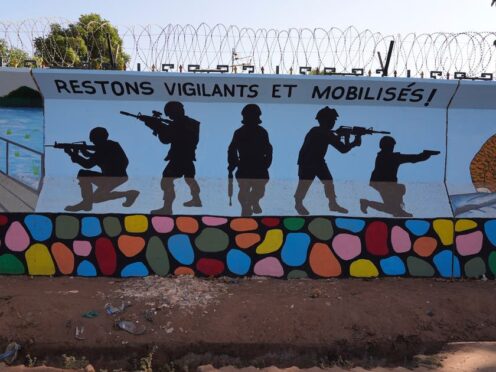A farmer has documented a massacre which took place in a Burkina Faso village.
The 32-year-old took a series of photos in the central village in Namentenga province after security forces launched an attack on November 5 last year, killing more than a dozen of his relatives.
The images the anonymous man took showed women who had been killed with babies wrapped against their bodies, lifeless children intertwined together, and a two-month-old child lying face-up on the ground with puppies crawling on his tiny frame.
The troops came with mounted pickup trucks, guns and drones, the farmer said.
He said he hid in a neighbour’s compound and took a series of photos before fleeing the next morning.
A grave security & humanitarian situation & impact of climate change – the suffering of the Burkinabe people must not slip off the int’l agenda.
My Office will do its best to accompany #BurkinaFaso through the next steps in the transition, rooted in human rights – @volker_turk
— UN Human Rights (@UNHumanRights) March 21, 2024
Dozens more people were killed that day in Zaongo village, according to the farmer’s account and that of two other survivors, as well as a UN report citing government figures.
The images the man sent to reporters and the interviews with the three survivors are rare first-hand accounts amid a stark increase in civilian killings by Burkina Faso’s security forces as the junta struggles to beat back a growing jihadi insurgency and attacks citizens under the guise of counter-terrorism.
Most attacks – including the killing of children by soldiers at a military base last year, uncovered in an AP investigation – go unpunished and unreported in a nation run by a repressive leadership that silences perceived dissidents.
More than 20,000 people have been killed since jihadi violence linked to al-Qaida and the so-called Islamic State group first hit the West African nation nine years ago, according to the Armed Conflict Location and Event Data Project, a US-based non-profit.
The fighting has divided a once peaceful population, blockaded dozens of cities and led to two military coups.
Burkina Faso’s government spokesman did not respond to requests for comment about the November 5 attack.
Frank & open exchanges with President of the Transition of Burkina Faso, Ibrahim Traoré, about the need for human rights to be at the centre of all efforts to manage the multifaceted challenges the country is facing. My sincere solidarity with the people of Burkina Faso.
— Volker Türk (@volker_turk) March 21, 2024
Previously, officials had denied killing civilians and claimed jihadis often disguise themselves as soldiers.
The three survivors told AP they are certain the men were security forces, not jihadis. They describe them wearing military uniforms, one with a Burkina Faso flag fastened to him.
The farmer saw a helicopter flying toward the village in the attack’s aftermath – those are used solely by the military, not insurgents.
The United Nations urged the government to investigate, hold those responsible accountable, and compensate victims, said Seif Magango, of the UN Human Rights Office.
Burkina Faso’s prosecutor’s office said it opened an investigation. Four months later, survivors said they have had no news.
